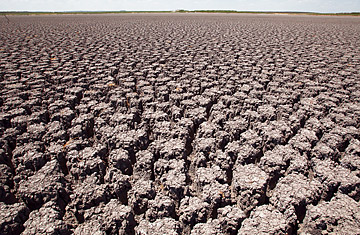
The Texas drought, which dried up San Angelo's O.C. Fisher Lake, shown on Aug. 3, 2011, is one of the most severe on record for the state
"If you don't like the weather, stick around." So goes the old saying in Texas, a land where Mother Nature's capricious ways are on display year round. Texas is a place where a storm cooked up in the mountains of Big Bend National Park can turn Hill Country creek beds into watery death traps within minutes, a state where a January dinner party can feature grilled steaks or pot roast, depending on which way the wind blows. But these days there is a tedious monotony to the weather.
Signaled by a dry fall last year, followed by a dry winter and then a dry spring, summer has turned torrid. The weather forecast has become a mantra of triple-digit temperatures and endless, cloudless blue skies, all symbolized by a giant H on the weather map, set among a sea of scarlet. That giant high-pressure dome has sat atop the state for over 30 days, and with August now under way, no relief is in sight.
The nine months from October 2010 through June of this year were the driest nine months on the books since the state began keeping records in 1895, according to the Lower Colorado River Authority (LCRA), which oversees Central Texas' vast system of lakes, dams and rivers that produces water and power for urban and rural customers alike. The Austin area is 16 in. below normal for rainfall, according to LCRA, while counties to the east of the Texas capital have a 20-in. deficit.
The Highland Lakes were built in the 1930s and '40s, damming up sections of the Colorado River to help provide water and control flooding. This year the lakes are shrinking as the water retreats. Increased water use by a growing population and evaporation — no rain leads to warmer temperatures — means the lakes will continue to fall 1 ft. a week until October, LCRA predicts, stranding boat docks and revealing once flooded landmarks. In East Texas, the retreating waters of Lake Nacogdoches exposed debris from the 2003 crash of the space shuttle Columbia.
The drought is not the longest in Texas history. A 10-year drought that took hold in 1940s and lasted into the next decade holds the record, but that was in the days of radio and black-and-white television, when the weather was discussed at the coffee shop, not constantly tweeted about or glaring on iPhone screens. This year's weather is feeding the 24-hour news cycle, prompting reporters to go beyond the fried-egg-on-the-sidewalk story. (How about chocolate-chip cookies baked on the dash of a parked car? It worked.) There is no new news in the weather, just a parade of whimsy and warning. This weekend, EMS workers medevacked a Highland Lakes resident to Austin after he fell asleep while sunbathing in the nude on a boat deck, resulting in second-degree burns over 40% of his body.
Staying out of the sun is the goal of most Texans. Shades down, ceiling fans on, temperatures set at 78°F with the hopes that the churning air conditioner is up to the task and that electricity will continue to flow during the peak hours — and the hottest — of 3 p.m. to 7 p.m. State energy officials have issued warnings of rolling blackouts, but, so far, none have kicked in.
The dog days of August have turned into the dog-less days. The playing fields are brown and yellow, dusty and cracked, and the grass crunches under feet. Neighbors emerge after sunset to walk the dogs, or turn on the sprinklers, if permitted. Most large urban areas have mandated water restrictions. (The exception is Fort Worth, which, while experiencing record water usage, has not reached the trigger point for once- or twice-weekly limits; the city has restricted daytime automatic sprinkling since 2007.) In Austin, only watering by hand is permitted during the day under current Stage 1 rules. The next stage would further limit watering to once a week, shut down the city's fountains and allow water to be served in restaurants only upon a customer's request. Sprinkler systems and soaker hoses can be utilized twice a week from 7 p.m. to midnight, and in this city of trees, Austinites keep an eye on treetops for browning leaves, a sure sign of stress for a lack of water to their deep roots. Water bills are running as high as electric bills for some Austin residents, prompting the city utility service to initiate a summer extended plan.
